- Here is an account of a yatra along the
Ganga from Varanasi to the Bay of Bengal and important pilgrimage places
enroute.
For the millions of devout Hindus living close to Ganga, every day is full of blessings from the sacred river. Our story takes us 1,200 miles down narrow roads from Varanasi to the Bay of Bengal, exploring the temples and ashrams that hug its banks. The abundance of Ganga is evident in the thousands of square miles of fertile land along its shores. Fifty percent of India’s food supply grows in these rich alluvial soils, which are replenished each year during the monsoon rains.
This
article was first published in Hinduism Today.
On February 20, 2021, I
commenced a pilgrimage down the Ganga from Haridwar to Gangasagar, where
the river enters the Bay of Bengal. I had just reached Varanasi when Covid-19
interrupted my journey. I described that first part of the pilgrimage in the July/August/September 2021 issue of Hinduism
Today. Now, with the easing of the pandemic, I had the green light to complete
my pilgrimage.
I spent one day in Varanasi to arrange transport—and, of course, to take in the Ganga Arati on Dashashvamedh Ghat in the evening and awake early the next morning to witness the sunrise. Morning walkers, ascetics, bathers, people lost in themselves with eyes closed and hands folded, priests hurriedly arranging their seats by the river—all throng the ghat with the first ray of light. After a typical Varanasi breakfast of deep-fried kachori with dry spiced potato alu subzi and jalebi sweets, I was ready to set off from the city.
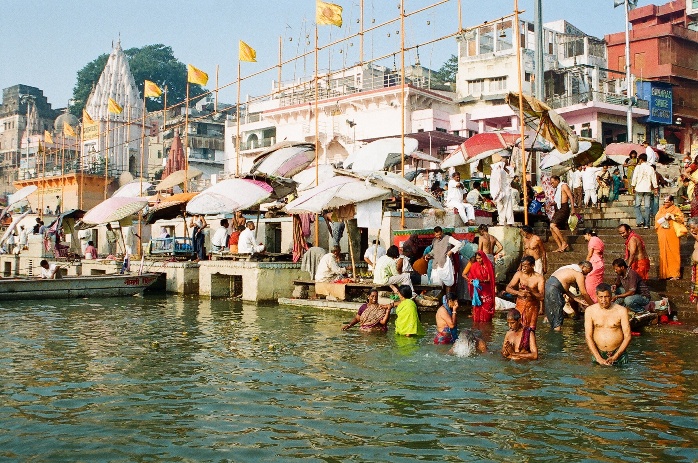 Ghats of Kashi.
Ghats of Kashi.
 Lady and Mother thank the Ganga through offering of sweets and sari.
Lady and Mother thank the Ganga through offering of sweets and sari.
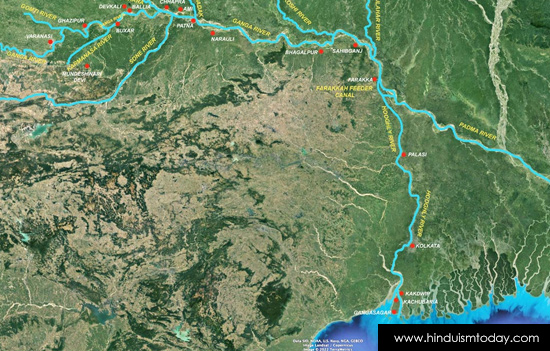 Google earth view of lower part of Ganga basin.
Google earth view of lower part of Ganga basin.
1. Bhabua to Ghazipur
I had arranged to take the route closest to the river, which meant enduring many small roads in poor condition. Such roads offer the true sensual experience of rural India in sights, sounds, smells—and bumps. Cows tied to their pegs in open courtyards, clusters of thatched roofed huts, women carrying water in earthen pitchers and that so very special smell of rural India: a mix of cow dung, burnt leaves, spices from food being prepared and wild blossoms.
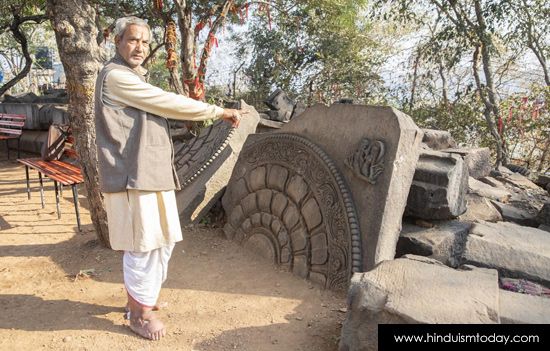 Acharya Dwivedi points one
of the broken Lakshi Yantra of Mundeshwari Temple.
Acharya Dwivedi points one
of the broken Lakshi Yantra of Mundeshwari Temple.
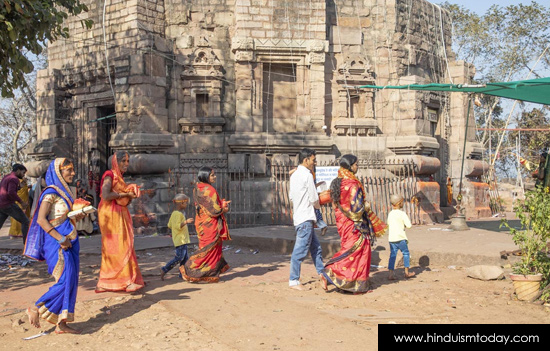 The severely damaged temple
still attracts thousands of devotees every day.
The severely damaged temple
still attracts thousands of devotees every day.
One such road, on Ganga’s right bank, leads to the small town Bhabua in Bihar, famous for Mundeshwari Devi Temple. Situated
60 miles from Varanasi at Ramyagiri Parvat, the temple is believed to be one of the oldest operational Hindu temples in India. Though there is no record of when it was built, an inscription found there indicates that it existed in 635 ce, at the time of King Harshvardhan’s rule in India. It is said the castle of a King Mand was here once upon a time.
A small road climbs the rocky
hillock to the temple. Much of the structure has been demolished over the
centuries, first by natural causes such as lightning strikes and later by Muslim attacks which systematically
dismantled or damaged most of it. Today Mundeshwari Temple is a protected
national monument, maintained by the Archaeological Survey of India.
Only the central structure,
where worship takes place, has been restored to some extent. Hundreds of broken
statues, intricately engraved pillars, arches and pieces of temple structure
are scattered around the huge complex. It is nevertheless a spiritually
powerful place, and one hopes in the future the ASI will set about a more
systematic restoration.
It is believed that Mundeshwari
Devi was a Deity of the vanvasi population. Today Her sanctuary is one of the
most important pilgrimage centers of Bihar and adjoining states. The temple is
an octagonal structure, a rare example of the Nagara style, with four doorways
opening in the cardinal directions. Each wall has a large niche, flanked by two
smaller niches on either side. Many are empty now, but must have originally
held beautiful figures of various Deities.
The canopy of the temple is believed
to have been destroyed by lightning, long before the onslaught of Muslim
invaders. There had been four additional temples in the complex, of Vishnu,
Brahma, Ganesha and Siva in the four directions. The central temple, covered
with a huge heap of debris from the four other temples, was spared from
complete destruction; apparently the invaders had no patience or time to remove
the debris and complete the demolition. The two pieces of a beautiful Lakshmi
Yantra are still lying in the courtyard.
On the temple’s main entrance are statues of guardian Gods and Goddesses. Most of these have been ruthlessly defaced, but they are still revered and worshiped by devotees. There are massive square pillars to support the roof of the sanctum, originally much higher. In the sanctum sanctorum is a large Sivalinga with four faces of Siva. The tall murti of Mundeshwari stands to the left.
Testifying to the craftsmanship
of the artisans who built the temple is a tall, cylindrical pot called Kuthia, about four feet high and two
feet in diameter. Made of solid stone, the vessel is intricately
decorated.
Thousands of devotees visit
Mundeshwari everyday, many of them returning to thank the Goddess and Lord Siva
for fulfilling their previous prayers. It is common to offer a goat, which in
the past would have been sacrificed but now is made to lie down next to the
priests performing the ritual, put into some kind of trance and then
released.
Local priests offer their
services to the temple on a rotational basis. They also help devotees with
performing rituals both inside and out of the temple, such as head shaving and
first feeding of a child, rudrabhishek,
puja to bless newlyweds, and the ever-popular blessing of newly purchased cars
or motorcycles.
2. Ghazipur to Ballia
The Gomti River joins the Ganga on the left bank between Varanasi and
Ghazipur, 50 miles downstream. Though most widely known for its opium factory
(the largest legal one in the world, established by the East India Company in
1820), Ghazipur has many ghats, temples and ashrams along the river. The Manav
Seva Sangh runs a large charitable eye hospital, Aarogya Ashram, established by
Swami
Sharananand near
the banks of Ganga.
The events, places and actions
of saints and sages described in the mythological stories become reality in
these temples and ashrams. The faith and belief of people bring the mythology
into real life. For example, there is a Vamana temple at Buxar on the right bank of the river
thirty-two miles downstream from Ghazipur. Here Vishnu appeared as Vamana, the
dwarf avatar who defeated the demon king Bali who had conquered many Gods.
Other stories mention Lord Rama visiting the ashrams of Vishvamitra, Gautama Rishi,
Narada Muni, Bhargava and Uddhalak, all of which are in this area.
The sprawling Shri Adinath Akhara Ashram and temple complex was established near the river in 1946 by the Nath Guru Shri Adinath Peethadhishwar Triloki Nath Maharaj, better known as Nath Baba. He passed away in Haridwar during the Kumbh Mela of 2021. Yogi Shri Nath, his successor, is the present head of the ashram, which is associated with the Nath Akara in Haridwar. According to Shri Nath, his guru was the embodiment of Lord Siva. “He was of the belief that there is no pageantry in Nath Sampradaya. Even while living a social life, one can show the way to salvation and happiness, way to salvation from 84,00,000 rebirths. Promoting virtue in society is their main objective.”
While I was there, Shri Nath told the devotees, “The divine medicinal properties of Ganga water cleanse body and mind and have the power to heal mental and physical ailments. One can attain liberation simply by remembering the name, having darshan or taking a bath in the heavenly water body called Ganga.” He relates that his guru often carried Ganga water from Gaumukh—the river’s origin in the Himalayas—all the way to the southern tip of India to offer to the Sivalinga at Rameshwaram.
Under the shade of giant mango
trees outside the ashram, groups of men, women and merrymaking children are
gathered around a display of clothes, gold jewellery and sweets. The people of
Buxar have chosen the precincts of the ashram for the purpose of matrimonial
alliances, a place where prospective brides and grooms meet. If they like each
other, a marriage may be fixed on the spot. People believe that when a marriage
is arranged at the holy place of Guru Adinath, there will be no scope for any
betrayal in the partnership. Just while I was there, at least four groups of
families were in meetings for this purpose. Parents and relatives come bringing
all kinds of offerings and sweets. If both parties agree and the marriage is
fixed, the girl and the boy put on elegant clothing. Red alta paste (a custom
of married women in the Gangetic plain) is applied to the feet of both the boy
and the girl. Later, the now-engaged couple go inside to seek the blessings of
Nath Baba.
Just below the ashram is the river ghat. Here I meet Umesh Paswan, who has come with his wife, mother and a few relatives to thank Goddess Ganga for blessings and fulfilling their wishes. They are offering a sari and sweets through a small ritual. Umesh says the sari will go to his mother. “It took us five years to make it to this ghat after our wishes came true. We will try to be back one more time.” The nearby Ramrekha Ghat is the most popular in Buxar, especially for the mundan, or head-shaving ceremony of children.
3. Ballia to Patna
Baleshwar Temple, the largest Siva temple of Ballia, is situated in the middle of the city. This beautiful old temple has a silver Sivalinga. It is said the town was washed away twice in history and this is the third rebuilding. The Sivalinga now established in the temple came here with flood water. The temple is known for its celebration of Mahashivaratri and for the remarkable devotion of its inhabitants. People come here from far and wide to cure their medical problems.
Outside the temple are the seats of priests with their display of offering plates for puja, which include rice, sandalwood powder, gangajal, milk for the Sivalinga, bel tree leaves and the datura flower, which is especially sacred to Lord Siva. According to Pandit Vidhyashankar, these puja plates are given to devotees at no charge. “We happily accept whatever they pay us after the puja inside the sanctorum.” Twenty-five priests perform the rituals in rotation.
In the corridors I find many
groups of men and women reciting mantras. There are also priests who perform
the recitation on behalf of a devotee, sometimes for days at a time.
In the nearby village of
Devkali is the Vimleshwar
Mahadev Temple,
surrounded by several sacred ponds. The unusual Sivalinga in this temple,
apparently made of brass, has five heads of Siva.
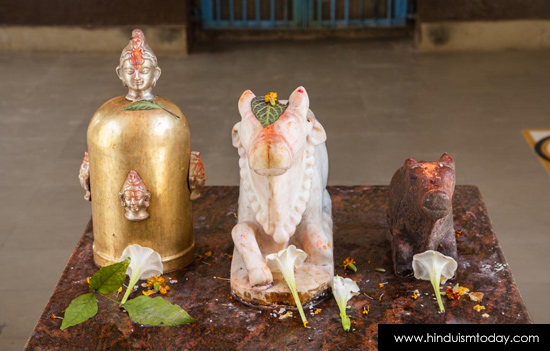 5-faced Shivalinga at Vimleshwar Mahadev Temple.
5-faced Shivalinga at Vimleshwar Mahadev Temple.
Travelling the 43 miles from
Ballia to Chhapra is a test of endurance and
strength: dust, potholes, no road signs and uncontrolled traffic of heavy
trucks! Miles and miles of road has been torn out to build a new road. The only
soothing element on these dusty roads is the blooming Semal trees, with those
large scarlet red flowers that attract all kinds of birds and insects. Herds of
Neelgai, the “Blue Cow,” are grazing freely in cultivated fields. Neelgai is the largest antelope in Asia. Herds of these often live close to cultivated areas near forests. Because gai, “cow,” is a part of their name, they are considered as sacred as the cow and left unharmed even if they feast on the crops—exemplifying the spirit of tolerance in Hinduism.
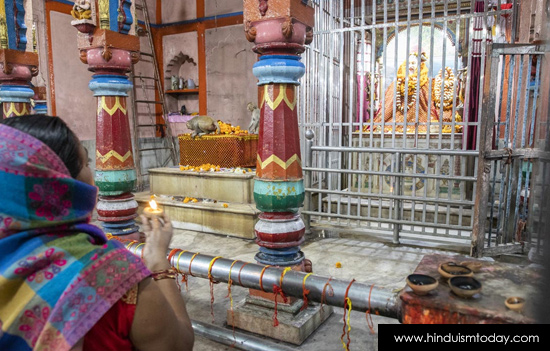 Temple of Rishi Bhrigu.
Temple of Rishi Bhrigu.
Our goal today is to reach the confluence of the Ghaghara with Ganga. This is Her second-largest tributary. As that country’s longest river, it originates on the Tibetan Plateau and flows through Nepal to meet the left bank of Ganga near Chhapra. In its lower reaches, Ghaghara is also called the Saryu. This is the river that flows past the sacred town of Ayodhya. The area is quite flat, with vast stretches of cultivated fields and a near total absence of trees. Each riverbed is more than a mile wide at this point, so the actual confluence is difficult to see from any vantage point.
I visit the Baba Dharmanath Dhani Temple, built not for a God but the saint Baba Dharmanath, a devout worshiper of Lord Siva who spent his life in meditation and service here a thousand years ago. Pandit Munna Kumar Mishra, the priest in the temple, says that seeing Baba’s devotion and selfless service to Him, Lord Siva appeared in person to bless him. After such divine liberation, Baba chose to go into meditation and consciously leave his body. His samadhi, or burial place, is in the temple.
Pilgrims from far-flung regions
visit Baba Dharmanath Temple with great faith. Many prefer this temple for
marriages. The temple complex has a beautiful garden and a dharmasala inn where
devotees spend the night. The temple donated enough land to the government to
construct a school.
A few miles downstream from
Chhapra, Ganga is joined on the right by the Sone River, a prominent tributary—another confluence one can’t really see from any vantage point.
 Ambika Bhawani Temple.
Ambika Bhawani Temple.
Continuing down the left bank,
we turn a few miles inland to the small town of Ami to visit the Ambika Bhawani temple, regarded as both a
Siddhapeeth and Shaktipeeth. The central murti is a unique earthen statue
depicting nine manifestations of Ma Durga. In a charming custom, devotees come
each evening to the temple bearing a ghee lamp which they offer to the Goddess.
Next to the temple is a small
pond fed by Ganga water. Worship is done here each day with various offerings
to establish the presence of the Goddess in the pond. Each morning devotees
come, make a wish and reach into the water to retrieve whatever they touch, be
it a flower, a grain of rice, or something else. They take this home with them.
When the wish is fulfilled, they return it to the pond.
No one can remain untouched by
the strong, divine vibration of the place, its silence, the fragrance of
incense and ghee lamps. Beaming faces and divine smiles of visiting devotees
bear witness to the fact that they are blessed by the Goddess.
In the evening, we continue on
to Patna, 30 miles downstream on the right bank. This is reached by the
three-mile-long Digha-Sonpur bridge, one of the longest in India. It crosses at
the confluence of the Gandhak River and the Ganga.
4. Patna to Narauli
The name Patna is derived from Patan Devi, a manifestation of Goddess Bhagavati and the chief Deity of the region. The religious life of the area revolves around Patan Devi Temple, one of the 51 Shaktipeeths of India. There are three forms of Bhagavati here: Maha Kali, Maha Lakshmi and Maha Saraswati. Their Bhairava, Vyomkesh Bhairava, a fierce form of Siva, sits nearby, as He does in all Shaktipeeth temples.
Patan Devi Temple has the tradition, also followed elsewhere in India, of having a sannyasin as head of the temple. I met the present Mahant, Vijay Shankar Giri, who explains, “For every auspicious celebration or ritual, people of the Patna region come here to seek blessings of the Devi.” Newlywed couples come with their families for Chauthari puja, the Bihar tradition in which they thank the Goddess for a successful wedding. As part of this puja, the groom’s mother hands over the keys of the household to the bride, signaling her taking on major responsibility in the family. Overall, Bihar weddings are among the most elaborate in all India.
The temple complex is flooded
with devotees engaged in diverse activities. Many families are sitting in close
clusters, holding their little boy as the barber wields his razor for the
mundan, or head-shaving ritual, which is accompanied by traditional songs. It
is fascinating to watch the variations in ceremonies, songs, languages, cuisine
and dress of the Ganga plains as I move from region to region.
As everywhere else along the
river, sacrifice of animals in Devi temples has become simply a symbolic
ritual. People come with goats, which are taken back home after being
symbolically offered to the Goddess.
While in Patna, I visited
the Mahavir Man-dir. Located in the heart of Patna city, this is one of India’s holiest Hanuman temples. Here one has to stand in queue for hours to receive darshan. Governed by the Shri Mahavir Sthan Nyas Samiti trust, the temple runs many philanthropic works.
At Narauli, some twenty-eight
miles downstream from Patna, childless couples throng the little Jagdamba Temple, also known as Karauti Wali Mayya. Here the feet of Jagdamba are worshiped, because the temple has only the feet of the Goddess—all that’s left of a broken statue. It is said that on his way to destroy Nalanda University, the scourge of Hindu temples, Bakhtyar Khilji, passed by this small village and broke the beautiful statue of Jagdamba.
The temple is situated under an
age-old peepal tree amid sprawling lawns. Red chunni, a small handkerchief, is
tied to a thinner branch of the spreading peepal or to the metallic grille of
the temple while making a wish. About 20,000 people come here every Tuesday and
Saturday, special days for Devi puja.
5. Narauli to Farakka
On the right bank of Ganga, 155
miles downstream from Patna, lies the city of Bhagalpur, world-renowned for its
silk, saris and other handloom products. A special attraction of the river here
is the Ganga dolphin, a rare freshwater variety. Vikramshila Gangetic Dolphin
Sanctuary has been established to protect it.
Standing out amidst a host of
temples and ghats in Bhagalpur is Maharishi
Mehi Ashram.
Maharishi Mehi Paramhansa was a great saint who lived a hundred and one years,
from 1885 to 1986. Sachchidanand Verma, a volunteer in the ashram, explains
that the place is a santmat ashram,
where ideas of all great saints of all religions are preached. They stress a
life of virtue and devotion.
Sachchidananda Paramhans Mahrishi Harinandan Ji Maharaj, the present head of the ashram, explains that it is a place of spirituality. “We educate visitors on traditional prayers in praise of the Gods, character building and meditation. Large crowds attend the daily satsangs which incorporate the teachings of all gurus.”
Baba Vradhdheshwar Nath Temple, is renowned throughout Bihar state. Situated
on the banks of Ganga, it is believed to have been established by Vashishta
Muni, and is mentioned in the Siva Purana.
Ancient palm-leaf records of
the temple are kept in the custody of the Mahant, Narayan Giri. Murtis of
Bhagawati and Baba Burhanath are housed inside the sanctum sanctorum. Devotees
offer silver necklaces to Bhagavati when their wishes are fulfilled. The temple
complex is very large, with murtis of Lakshmi Narain, Kalbhairav, Balram,
Ganga, Annapurna, Hanuman and Kali. Pandit Pawanendra Jha of the temple said
they suffered a lot from the dramatic drop in income during the Covid-19
pandemic.
Burhanath Temple has a large dharmasala for pilgrims and a big gaushala for cows. People from far-flung areas in Nepal, Bihar, Bengal and Uttar Pradesh come here to be married. Sometimes as many as fifty couples marry in a single day. The temple charges just $13.50 for the simple Vedic wedding. “The chances of quarrels and divorces are surprisingly reduced in weddings that take place in this temple,” explains Pandit Jha.
The art of weaving fine silk and cotton is an age-old family tradition of Bhagalpur. Narrow alleys in the weavers’ colony display sparkling colors of threads being dried or colored outside small houses. Women young and old are busy preparing rolls of thread. Over time, handlooms have been replaced by power looms. Almost every house has a power loom inside where men are busy weaving fabric.
At Kursela, near Kataria, on
the left bank of Ganga about fifty miles from Bhagalpur, is Trimohini Sangam, where the Koshi river meets the Ganga. This was one of the several places where Mahatma Gandhi’s ashes were immersed in 1948. A small stream by the name Kalbalia originates from the confluence. Because of its erratic nature, Koshi is called the “Sorrow of Bihar,” as it inundates large areas of Bihar during monsoons, resulting in damage to property, crops and animals, causing millions of dollars in losses.
It takes hours to cover the
distance of just 47 miles from Bhagalpur to Sahibganj. For most of this
distance, the Ganga remains quite far north from the road. At Sahibganj is the
Atal Bihari Vajpayee Harbour. Here an Inland Waterway Transport Terminal is now
being developed to use Ganga for transport of heavy commodities far inland on
the river.
The Fulahar River, originating
in Nepal, meets the Ganga on the left bank opposite Rajmahal.
6. Sahibganj to Kolkata
After Sahibganj, Ganga takes a
sharper turn to the southeast to reach Farakka in West Bengal. The 55 miles of
bad road between these towns is sparsely populated. There are hundreds of brick
kilns. Digging earth for the bricks has left the landscape denuded and
unsuitable for crops. A low, multi-gated dam was constructed across the river
at Farakka in 1975. Here we enter West Bengal.
The Ganga to the northeast soon enters Bangladesh, where it is known as the Padma, but still crosses the border to re-enter India multiple times. We follow the Hooghly River toward Kolkata. This is one of the many distributary channels of Ganga’s delta region, all of which are still technically the Ganga River. The Hooghly, not a big river originally, is now fed by substantial water from the dam at Farakka under an international agreement with Bangladesh.
The state of West Bengal is
densely populated. Rice is the main crop in this fertile land. We pass through
Plassey on our way to Kolkata. This was the site of the Battle of Plassey in
1757, in which the Nawab of Bengal and his French allies were defeated by the
British East India Company. About a mile west of Plassey is a busy jetty on the
Hooghly, where commuters travel across the river in a ferry, with their
bicycles, motorcycles, cars and even large buses. The ferry saves miles of
travel compared to crossing by the bridge.
7. Our Final Days
Once in Kolkata, the pace of
our travel eases and we take the time to enjoy the sights and sounds of this
huge city. A great way to do this is by boat ride, particularly the longer
rides to ghats upstream of the Howrah bridge, a famous symbol of Kolkata. It is
a wonderful experience to see the giant bridge from such an odd angle, from
beneath. The ghats are not so enjoyable, as they are not very clean, but still
people visit them.
The huge flower market below the Howrah bridge comes alive with the first ray of light. It is a photographer’s delight with its otherworldly display of colors and its fragrances. Hundreds of flower sellers set up their stalls with all kinds of flowers in many hues and colors. There are loose flowers, garlands and bouquets. Most of the flowers are destined for temples and home shrines.
Rather than visit many temples
in Kolkata, I pilgrimage to Ganga Sagar island, 70 miles from the city, where the river meets the Bay of
Bengal.
Getting there is not easy. First, one takes a road 53 miles to Harwood Point, then a ferry to the Kachuberia Jetty on the north end of the island. Another 18 miles by local transport brings one to the island’s southern tip—Gangasagar, one of the holiest places of the Hindu religion, where the Ganga ends its long journey to the sea. A pilgrimage here is the goal of many Hindus, and thousands arrive here daily. Yearly on Makar Sankranti, when the Sun enters Capricorn in the month of January, more than three million people come for the Gangasagar Mela.
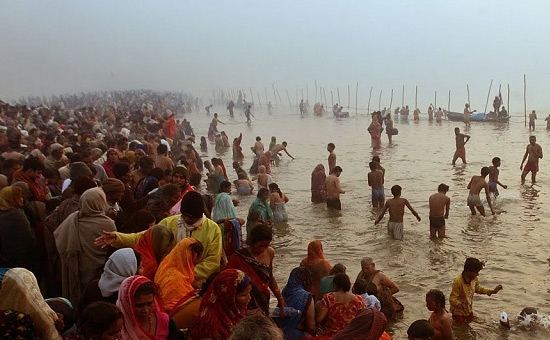 Gangasagar.
Gangasagar.
The island of Sagar has
innumerable ashrams and rest houses for pilgrims, where food and lodging can be
arranged at nominal cost. If coming during the Mela, transport and accommodations
must definitely be arranged in advance.
I meet Subhash Chandra who is from Jind, Haryana. He was visiting Gangasagar with sixteen other people. They had travelled a thousand miles by train to reach Kolkata. Overwhelmed by his feat of making it to the distant island, Subhash feels spiritually elevated—an emotion he shared with me. He exclaimed, “I had wished to be here since long. And now the time came for it!”
They take a dip in the holy
water, make offerings of arghya to the Sun and conduct other rituals with the
help of a priest. In the morning they again performed puja, visit the Kapil
Muni Ashram and return to Kolkata.
8. Conclusion
To me, the long journey down
the greatest river of India is a pilgrimage in itself. Not only did it offer an
opportunity to visit many sacred ghats, ashrams and temples, it convinced me
that all the stories of our epics hold truth. The places mentioned in stories,
hymns and mantras do exist. Characters lived exactly in the same places as
mentioned in the Ramayana, Mahabharata, Puranas and
other scriptures. The descriptions in the scriptures of the Himalayas, the
rivers, the land features are all geographically true.
This pilgrimage demonstrated to
me the direct relation between the diversity of nature and the diversity of
songs, music, cuisine, languages, dress, rituals and, most of all, the people
of this great country called Bharat!
This
article was first published in Hinduism Today and here.
eSamskriti has obtained permission from Hinduism Today to share.